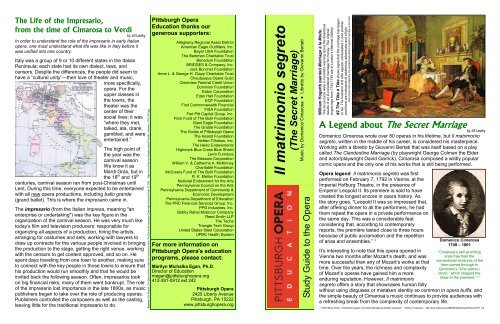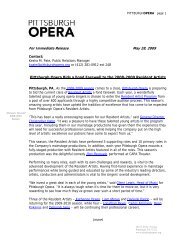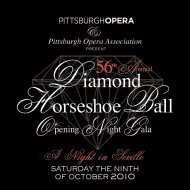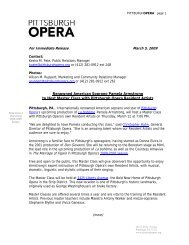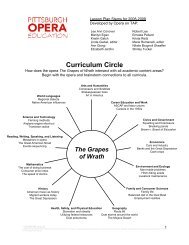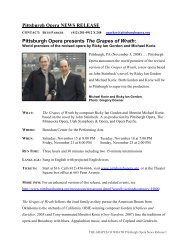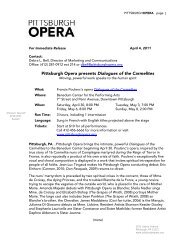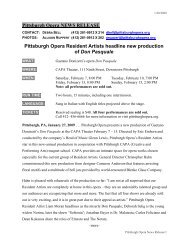View the STUDY GUIDE for Il matrimonio segreto ... - Pittsburgh Opera
View the STUDY GUIDE for Il matrimonio segreto ... - Pittsburgh Opera
View the STUDY GUIDE for Il matrimonio segreto ... - Pittsburgh Opera
Create successful ePaper yourself
Turn your PDF publications into a flip-book with our unique Google optimized e-Paper software.
The Life of <strong>the</strong> Impresario,<br />
from <strong>the</strong> time of Cimarosa to Verdi<br />
by Jill Leahy<br />
In order to understand <strong>the</strong> role of <strong>the</strong> impresario in early Italian<br />
opera, one must understand what life was like in Italy be<strong>for</strong>e it<br />
was unified into one country.<br />
Italy was a group of 9 or 10 different states in <strong>the</strong> Italian<br />
Peninsula; each state had its own dialect, laws, and<br />
censors. Despite <strong>the</strong> differences, <strong>the</strong> people did seem to<br />
have a “cultural unity”—<strong>the</strong>ir love of <strong>the</strong>ater and music,<br />
more specifically,<br />
opera. For <strong>the</strong><br />
upper classes in<br />
<strong>the</strong> towns, <strong>the</strong><br />
<strong>the</strong>ater was <strong>the</strong><br />
center of <strong>the</strong>ir<br />
social lives; it was<br />
“where <strong>the</strong>y met,<br />
talked, ate, drank,<br />
gambled, and were<br />
entertained.”<br />
The high point of<br />
<strong>the</strong> year was <strong>the</strong><br />
carnival season.<br />
We know it as<br />
Mardi Gras, but in<br />
<strong>the</strong> 18 th and 19 th<br />
centuries, carnival season ran from post-Christmas until<br />
Lent. During this time, everyone expected to be entertained<br />
with all new opera productions, including ballo grande<br />
(grand ballet). This is where <strong>the</strong> impresario came in.<br />
The impresario (from <strong>the</strong> Italian impresa, meaning "an<br />
enterprise or undertaking") was <strong>the</strong> key figure in <strong>the</strong><br />
organization of <strong>the</strong> carnival season. He was very much like<br />
today’s film and television producers: responsible <strong>for</strong><br />
organizing all aspects of a production, hiring <strong>the</strong> artists,<br />
arranging <strong>for</strong> costumes and sets, working with lawyers to<br />
draw up contracts <strong>for</strong> <strong>the</strong> various people involved in bringing<br />
<strong>the</strong> production to <strong>the</strong> stage, getting <strong>the</strong> right venue, working<br />
with <strong>the</strong> censors to get content approved, and so on. He<br />
spent days traveling from one town to ano<strong>the</strong>r, making sure<br />
to connect with <strong>the</strong> key people in those towns to ensure that<br />
his production would run smoothly and that he would be<br />
invited back <strong>the</strong> following season. Often, impresarios took<br />
on big financial risks; many of <strong>the</strong>m went bankrupt. The role<br />
of <strong>the</strong> impresario lost importance in <strong>the</strong> late 1800s, as music<br />
publishers began to take over <strong>the</strong> role of producing operas.<br />
Publishers controlled <strong>the</strong> composers as well as <strong>the</strong> casting,<br />
leaving little <strong>for</strong> <strong>the</strong> traditional impresario to do.<br />
Sources: John Rosselli, The <strong>Opera</strong> Industry in Italy from Cimarosa to Verdi: The Role of <strong>the</strong> Impresario (Cambridge University Press), © 1984. Map found at http://en.wikipedia.org/wiki/File:Italy_unification_1815_1870.jpg<br />
<strong>Pittsburgh</strong> <strong>Opera</strong><br />
Education thanks our<br />
generous supporters:<br />
Allegheny Regional Asset District<br />
American Eagle Outfitters, Inc.<br />
Bayer USA Foundation<br />
The Berkman Charitable Trust<br />
Benedum Foundation<br />
BRIDGES & Company, Inc.<br />
Jack Buncher Foundation<br />
Anne L. & George H. Clapp Charitable Trust<br />
Chautauqua <strong>Opera</strong> Guild<br />
Clearview Federal Credit Union<br />
Dominion Foundation<br />
Eaton Corporation<br />
Eden Hall Foundation<br />
EQT Foundation<br />
First Commonwealth Financial<br />
FISA Foundation<br />
Fort Pitt Capital Group, Inc.<br />
Frick Fund of The Buhl Foundation<br />
Giant Eagle Foundation<br />
The Grable Foundation<br />
The Guilds of <strong>Pittsburgh</strong> <strong>Opera</strong><br />
The Hearst Foundation<br />
Hefren-Tillotson, Inc.<br />
The Heinz Endowments<br />
Highmark Blue Cross Blue Shield<br />
Levin Furniture<br />
The Massaro Corporation<br />
William V. & Ca<strong>the</strong>rine A. McKinney<br />
Charitable Foundation<br />
McCreery Fund of The Buhl Foundation<br />
R. K. Mellon Foundation<br />
National Endowment <strong>for</strong> <strong>the</strong> Arts<br />
Pennsylvania Council on <strong>the</strong> Arts<br />
Pennsylvania Department of Community &<br />
Economic Development<br />
Pennsylvania Department of Education<br />
The PNC Financial Services Group, Inc.<br />
PPG Industries, Inc.<br />
Bobby Rahal Motorcar Company<br />
Reed Smith LLP<br />
The Techs<br />
Triangle Tech Group<br />
United States Steel Corporation<br />
UPMC Health System<br />
For more in<strong>for</strong>mation on<br />
<strong>Pittsburgh</strong> <strong>Opera</strong>'s education<br />
programs, please contact:<br />
Marilyn Michalka Egan, Ph.D.<br />
Director of Education<br />
megan@pittsburghopera.org<br />
412-281-0912 ext 242<br />
<strong>Pittsburgh</strong> <strong>Opera</strong><br />
2425 Liberty Avenue<br />
<strong>Pittsburgh</strong>, PA 15222<br />
www.pittsburghopera.org<br />
<strong>Il</strong> <strong>matrimonio</strong> <strong>segreto</strong><br />
(The Secret Marriage)<br />
Music by Domenico Cimarosa ● Libretto by Giovanni Bertati<br />
Study Guide to <strong>the</strong> <strong>Opera</strong><br />
William Hogarth painted Marriage à la Mode.<br />
Production The six pictures Photo by were Tim a Ma<strong>the</strong>son moralistic at warning Vancouver about <strong>Opera</strong> <strong>the</strong> disastrous<br />
results of an ill-considered marriage <strong>for</strong> money. The original<br />
engravings from 1743-1745 are in London’s National Gallery.<br />
#2 The Tête à Tête shows signs that <strong>the</strong> marriage has begun<br />
to fail. The husband and wife appear uninterested in one ano<strong>the</strong>r<br />
and <strong>the</strong>re are indicators of adulterous adventures and a fight.<br />
http://www.nationalgallery.org.uk/paintings/william-hogarth-marriage-a-la-mode<br />
A Legend about The Secret Marriage<br />
by Jill Leahy<br />
Domenico Cimarosa wrote over 80 operas in his lifetime, but <strong>Il</strong> <strong>matrimonio</strong><br />
<strong>segreto</strong>, written in <strong>the</strong> middle of his career, is considered his masterpiece.<br />
Working with a libretto by Giovanni Bertati that was itself based on a play<br />
called The Clandestine Marriage (by playwright George Colman <strong>the</strong> Elder<br />
and actor/playwright David Garrick), Cimarosa composed a wildly popular<br />
comic opera and <strong>the</strong> only one of his works that is still being per<strong>for</strong>med.<br />
<strong>Opera</strong> legend <strong>Il</strong> <strong>matrimonio</strong> <strong>segreto</strong> was first<br />
per<strong>for</strong>med on February 7, 1792 in Vienna, at <strong>the</strong><br />
Imperial Hofburg Theatre, in <strong>the</strong> presence of<br />
Emperor Leopold II. Its premiere is said to have<br />
created <strong>the</strong> longest encore in opera history. As<br />
<strong>the</strong> story goes, “Leopold II was so impressed that,<br />
after offering dinner to all <strong>the</strong> per<strong>for</strong>mers, he had<br />
<strong>the</strong>m repeat <strong>the</strong> opera in a private per<strong>for</strong>mance on<br />
<strong>the</strong> same day. This was a considerable feat<br />
considering that, according to contemporary<br />
reports, <strong>the</strong> première lasted close to three hours<br />
because of public acclamation and <strong>the</strong> repetition<br />
of arias and ensembles.” ¹<br />
It’s interesting to note that this opera opened in<br />
Vienna two months after Mozart’s death, and was<br />
more successful than any of Mozart’s works at that<br />
time. Over <strong>the</strong> years, <strong>the</strong> richness and complexity<br />
of Mozart’s operas have gained him a more<br />
enduring reputation. However, <strong>Il</strong> <strong>matrimonio</strong><br />
<strong>segreto</strong> offers a story that showcases human folly<br />
Domenico Cimarosa<br />
1749 – 1801<br />
“Cimarosa’s skill at writing<br />
arias free from <strong>the</strong><br />
conventional strictures of <strong>the</strong><br />
<strong>for</strong>m comes through in<br />
Geronimo’s “Che saltino i<br />
dinari,” which stopped <strong>the</strong><br />
show at <strong>the</strong> premiere.” ²<br />
without using disguises or mistaken identity so common in opera buffa, and<br />
<strong>the</strong> simple beauty of Cimarosa’s music continues to provide audiences with<br />
a refreshing break from <strong>the</strong> complexity of contemporary life.<br />
¹ Ox<strong>for</strong>d Music Online: <strong>Il</strong> <strong>matrimonio</strong> <strong>segreto</strong> (The Secret Marriage) by Gordana Lazarevich ² Anthony Tommasini — http://www.nytimes.com/2008/05/30/arts/music/30cima.html?_r=0
The Secret Marriage Synopsis<br />
Adapted from <strong>Opera</strong> Theatre of St. Louis<br />
Setting: We are in <strong>the</strong> household of Geronimo, a wealthy citizen of<br />
Bologna. He has two daughters, Elisetta and Carolina, and a sister<br />
Fidalma, who runs <strong>the</strong> household. He also has a young secretary,<br />
Paolino, who is secretly married to <strong>the</strong> younger daughter, Carolina.<br />
ACT I. Paolino and Carolina discuss how to stay calm<br />
("Cara, non dubitar"). Paolino is working to arrange a<br />
marriage contract between Elisetta and his patron, Count<br />
Robinson, hoping that as soon as Geronimo's older<br />
daughter is well married, his marriage to <strong>the</strong> younger one<br />
will be acceptable. Count Robinson has written a letter<br />
expressing interest—tempted by Elisetta's substantial<br />
dowry—and Geronimo is thrilled to think that his daughter<br />
will be a Countess ("Udite, tutti udite"). Fidalma<br />
confesses to her niece that she is in love, too, but only<br />
reveals in an aside to <strong>the</strong> audience that she has her eye<br />
on Paolino.<br />
When <strong>the</strong> Count arrives, he is disappointed to find that it is<br />
not Carolina who has been offered to him ("Senza tante<br />
cerimonie"). He tells Paolino that he will be content with a<br />
smaller dowry and sends him off to arrange <strong>the</strong> match.<br />
Carolina doesn't dare tell <strong>the</strong> Count that she is married, so<br />
when she admits she has no lover, it excites him fur<strong>the</strong>r.<br />
She tries to convince him that she has no desire or<br />
qualification to be a countess ("Perdonate, signor mio"),<br />
but he continues to pursue her. Elisetta accuses <strong>the</strong>m both<br />
of betraying her, and <strong>the</strong> commotion attracts Fidalma, who<br />
joins Carolina in trying to calm Elisetta ("Lasciatemi, signore"). Everyone tries at once to explain<br />
his or her feelings to <strong>the</strong> confused and exasperated Geronimo ("Orsù, saper conviene").<br />
Intermission<br />
Characters Characters Characters of of <strong>the</strong> <strong>the</strong> <strong>Opera</strong> <strong>Opera</strong><br />
<strong>Opera</strong><br />
Paolino [pah-oh-LEE-noh] tenor<br />
Clerk of Geronimo who is secretly married to<br />
his daughter Carolina. In order to gain<br />
Geronimo’s approval of <strong>the</strong>ir marriage,<br />
Paolino arranges a marriage contract<br />
between Elisetta and Count Robinson.<br />
Carolina [kah-roh-LEE-nah] soprano<br />
Geronimo’s younger daughter who is<br />
secretly married to Paolino.<br />
Geronimo [jay-ROH-nee-moh] bass<br />
A rich merchant who is deaf. He is <strong>the</strong> fa<strong>the</strong>r<br />
of Elisetta and Carolina, bro<strong>the</strong>r of Fidalma,<br />
and employer of Paolino.<br />
Elisetta [eh-lee-ZEH-tah] soprano<br />
Older daughter of Geronimo and sister of<br />
Carolina. As <strong>the</strong> elder daughter, she must be<br />
married be<strong>for</strong>e Carolina.<br />
Fidalma [fee-DAHL-mah] contralto<br />
Sister of Geronimo, aunt of Carolina and<br />
Elisetta. She is in love with Paolino.<br />
Count Robinson bass<br />
A wealthy nobleman and <strong>for</strong>mer employer of<br />
Paolino. He is betro<strong>the</strong>d to Elisetta <strong>for</strong> a<br />
large dowry, but prefers to marry Carolina<br />
instead, <strong>for</strong> a smaller dowry.<br />
ACT II. Geronimo insists that <strong>the</strong> Count must honor his contract and marry Elisetta, but <strong>the</strong> Count<br />
refuses. When he offers to accept a smaller dowry with Carolina's hand instead, Geronimo is<br />
delighted to save face and money—as long as Elisetta agrees. Paolino is distraught, and throws<br />
himself on Fidalma's mercy, but is stunned to find that she hopes to marry him ("Sento, ahimé!<br />
che mi vien male"). He faints, giving her <strong>the</strong> idea that he returns her emotion and making Carolina<br />
think she has been betrayed, but he promises that <strong>the</strong>y will leave <strong>the</strong> house at dawn and take<br />
refuge in <strong>the</strong> house of a relative ("Pria che spunti in ciel l'aurora").<br />
The Count tells Elisetta all his bad habits and physical defects, hoping she'll reject him, but she<br />
stands firm—and he finally confesses that he cannot abide her. Geronimo can't persuade her<br />
ei<strong>the</strong>r. Fidalma suggests sending Carolina to a convent, and Geronimo agrees ("Deh! lasciate<br />
ch'io respiri"). Carolina is broken-hearted and tries to confess her predicament to <strong>the</strong> Count, but<br />
<strong>the</strong>y are interrupted by her sister, her aunt, and her fa<strong>the</strong>r, who are gleeful at having caught <strong>the</strong>m<br />
toge<strong>the</strong>r ("Sortite, sortite"). Geronimo sends Paolino off with a letter to <strong>the</strong> Mo<strong>the</strong>r Superior.<br />
After a brilliant and farcical finale, Paolino and Carolina finally confess <strong>the</strong>y have been married <strong>for</strong><br />
two months. Geronimo and Fidalma are furious, but <strong>the</strong> Count and Elisetta advise <strong>the</strong>m to <strong>for</strong>give<br />
<strong>the</strong> newlyweds, adding that <strong>the</strong>y <strong>the</strong>mselves will marry after all ("Ascoltate un uom di mondo").<br />
Marriage à la Mode, a series of six<br />
paintings by William Hogarth, 1743 – 1745.<br />
#1 The Marriage Contract shows an<br />
arranged marriage between <strong>the</strong> son of bankrupt<br />
Earl Squanderfield and <strong>the</strong> daughter of a<br />
wealthy, miserly city merchant. (Painting #2 on p 1.)<br />
#3 The Inspection shows <strong>the</strong> Count<br />
and a prostitute, with syphilis, visiting a quack.<br />
#4 The Toilette shows <strong>the</strong> Countess<br />
and lover hosting a reception in her bedroom.<br />
#5 The Bagnio shows <strong>the</strong> Count fatally<br />
wounded by his wife’s lover.<br />
#6 The Lady’s Death shows <strong>the</strong><br />
Countess poisoning herself; her baby is infected.<br />
A Master of Dramma Giocoso<br />
by Jill Leahy<br />
Domenico Cimarosa was born on December 17, 1749 in<br />
Aversa, a small town in sou<strong>the</strong>rn Italy not far from Naples. His<br />
parents were poor but, as was often <strong>the</strong> case in those times, <strong>the</strong>y<br />
sent Cimarosa to a nearby monastery where he could receive a<br />
free education. Showing great promise, Cimarosa was awarded a<br />
scholarship to a prestigious music school in Naples and he<br />
continued his studies <strong>the</strong>re under several Italian music masters.<br />
Beginning at <strong>the</strong> age of 23, and <strong>for</strong> much of <strong>the</strong> rest of his life,<br />
Cimarosa composed operas, mostly dramma giocoso (a.k.a.<br />
opera buffa), and sacred pieces. He traveled throughout Italy<br />
conducting his music and creating works <strong>for</strong> <strong>the</strong> “stagione”, which<br />
is Italian <strong>for</strong> “season”, an organizational system used by larger<br />
houses <strong>for</strong> presenting opera. He was a member of <strong>the</strong> Neapolitan<br />
School, a group of composers who lived and worked around<br />
Naples, which was a significant musical center in <strong>the</strong> 1700s.<br />
Cimarosa composed over 80 operas and was celebrated as a<br />
composer during his lifetime, although he is not as famous today<br />
as some of his contemporaries, such as Mozart and Salieri.<br />
In 1787, he received an invitation from <strong>the</strong> Empress Ca<strong>the</strong>rine II<br />
(Ca<strong>the</strong>rine <strong>the</strong> Great) to come to St. Petersburg, where he stayed<br />
until Emperor Leopold II invited him to Vienna in 1792. There,<br />
Cimarosa collaborated with Giovanni Bertati to adapt The<br />
Clandestine Marriage, a 1766 comedy by George Colman <strong>the</strong><br />
Elder and David Garick. The idea <strong>for</strong> <strong>the</strong> play came from a series<br />
of William Hogarth paintings from 1743-1745 called Marriage à la<br />
Mode. The six pictures pointedly skewered upperclass 18thcentury<br />
society, depicting disastrous results of marrying <strong>for</strong><br />
money. <strong>Il</strong> <strong>matrimonio</strong> <strong>segreto</strong> was Cimarosa's masterpiece: Verdi<br />
considered it to be <strong>the</strong> model opera buffa and <strong>the</strong> Naples<br />
audience received it with great acclaim.<br />
Later, Cimarosa returned to Italy where he became involved in<br />
some political intrigues that resulted in his being banished from<br />
Naples. He died at <strong>the</strong> age of 52 on January 11, 1801 in Venice.<br />
The Librettist Devoted to Dramma Giocoso<br />
by Jill Leahy<br />
Giovanni Bertati was born on July 10, 1735 in a province of<br />
Venice called Martellago. He wrote his first libretto at <strong>the</strong> age of<br />
28, and from <strong>the</strong>n on, he worked prolifically, creating at least 70<br />
known librettos during <strong>the</strong> course of his long career. Bertati visited<br />
Vienna several times, and was <strong>for</strong>tunate enough to win <strong>the</strong> favor of<br />
Emperor Leopold II, who gave him <strong>the</strong> title of Poeta Cesareo<br />
("Imperial Poet") of <strong>the</strong> Italian <strong>Opera</strong> in Vienna, replacing Lorenzo<br />
da Ponte, who had fallen out of <strong>the</strong> emperor’s good graces. During<br />
Bertati’s career as a librettist, he almost exclusively wrote drammi<br />
giocosi. While <strong>Il</strong> <strong>matrimonio</strong> <strong>segreto</strong> is considered Cimarosa’s<br />
masterpiece, it was also Bertati’s most celebrated libretto.


